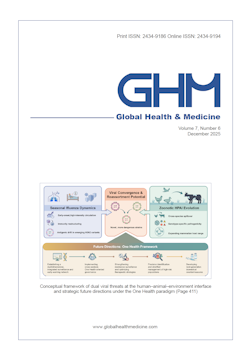Global Health & Medicine 2024;6(2):132-140.
Decreased resting-state functional connectivity and brain network abnormalities in the prefrontal cortex of elderly patients with Parkinson's disease accompanied by depressive symptoms
Tian BJ, Chen Q, Zou M, Xu X, Liang YQ, Liu YY, Hou MM, Zhao JH, Liu ZG, Jiang LP
This study aimed to explore the brain network characteristics in elderly patients with Parkinson's disease (PD) with depressive symptoms. Thirty elderly PD patients with depressive symptoms (PD-D) and 26 matched PD patients without depressive symptoms (PD-NOD) were recruited based on HAMD-24 with a cut-off of 7. The restingstate functional connectivity (RSFC) was conducted by 53-channel functional near-infrared spectroscopy (fNIRS). There were no statistically significant differences in MMSE scores, disease duration, Hoehn-Yahr stage, daily levodopa equivalent dose, and MDS-UPDRS III between the two groups. However, compared to the PD-NOD group, the PD-D group showed significantly higher MDS-UPDRS II, HAMA-14, and HAMD-24. The interhemispheric FC strength and the FC strength between the left dorsolateral prefrontal cortex (DLPFC-L) and the left frontal polar area (FPA-L) was significantly lower in the PD-D group (FDR p < 0.05). As for graph theoretic metrics, the PD-D group had significantly lower degree centrality (aDc) and node efficiency (aNe) in the DLPFC-L and the FPA-L (FDR, p < 0.05), as well as decreased global efficiency (aEg). Pearson correlation analysis indicated moderate negative correlations between HAMD-24 scores and the interhemispheric FC strength, FC between DLPFC-L and FPA-L, aEg, aDc in FPA-L, aNe in DLPFC-L and FPA-L. In conclusion, PD-D patients show decreased integration and efficiency in their brain networks. Furthermore, RSFC between DLPFC-L and FPA-L regions is negatively correlated with depressive symptoms. These findings propose that targeting DLPFC-L and FPA-L regions via non-invasive brain stimulation may be a potential intervention for alleviating depressive symptoms in elderly PD patients.
DOI: 10.35772/ghm.2023.01043







